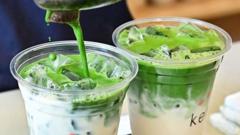Matcha fever is taking over the world as the vibrant green Japanese tea becomes the star ingredient in a wide array of products, from Starbucks lattes in the UK to Krispy Kreme doughnuts in Singapore. This growing fascination with matcha, driven largely by social media, has sent the "Matcha Tok" hashtag skyrocketing to tens of millions of views. Additionally, Japan's recovery in tourism following the pandemic and its favorable currency exchange rates have further increased interest in Japanese goods, particularly matcha.
The resulting demand surge has created a notable shortage. Lauren Purvis, an importer from the US, shared that her clients are experiencing rapid depletion of what was once considered a month’s supply of matcha, sometimes vanishing within days. Ms. Purvis stated that some cafes are now struggling to keep up, requesting as much as a kilo of matcha a day.
Moreover, a combination of extreme weather events and tariffs imposed on Japanese goods by the US is pushing matcha prices upward. The cultivation of matcha, which boasts unique health benefits and flavors, relies on a meticulous process that can be compromised by weather conditions. The Kyoto region, which accounts for 25% of Japan's tencha (the leaves used for matcha), has been heavily impacted by heatwaves, leading to diminished yields. Moreover, the aging farmer population in Japan threatens future matcha production.
Shops in areas renowned for their matcha offerings are witnessing rapid sell-outs, especially with tourists keen to purchase premium products. For instance, in Uji, a city famed for matcha, retailers are limiting sales to stave off complete depletion of their stocks. Atsuko Mori, who oversees operations at a local tea shop, confirms that tourist numbers have surged, complicating stock management further.
In response to these shortages, the prices for matcha have significantly risen. Chazen, a tea ceremony business in Tokyo, had to increase its matcha prices by 30% this year. Rie Takeda, a tea master at Chazen, expressed mixed feelings about the increase in enthusiasm for matcha, noting it presents an opportunity for greater cultural appreciation.
Amidst the fervor, there is a movement advocating for mindful consumption of matcha. Some customers have been highlighted for stockpiling matcha or using high-quality matcha in culinary applications, which dilutes its flavor. The Global Japanese Tea Association suggests that consumers try lower-grade matcha for cooking, preserving the premium quality for traditional consumption.
Recent findings indicate that matcha production has tripled from 2010 to 2023, correlating with a 25% increase in green tea exports last year. However, looming tariffs from the US on Japanese imports could lead to further price hikes, as announced in a recent trade deal entailing a 15% import tax on Japanese goods effective immediately.
Matcha distributors like Purvis remain apprehensive about the future, although Masahiro Nagata of Matcha Tokyo believes there may soon be a recalibration of prices. He speculates that the current boom is temporary and predicts the demand will stabilize within the next two to three years, potentially alleviating some of the pricing pressures in the market.
The resulting demand surge has created a notable shortage. Lauren Purvis, an importer from the US, shared that her clients are experiencing rapid depletion of what was once considered a month’s supply of matcha, sometimes vanishing within days. Ms. Purvis stated that some cafes are now struggling to keep up, requesting as much as a kilo of matcha a day.
Moreover, a combination of extreme weather events and tariffs imposed on Japanese goods by the US is pushing matcha prices upward. The cultivation of matcha, which boasts unique health benefits and flavors, relies on a meticulous process that can be compromised by weather conditions. The Kyoto region, which accounts for 25% of Japan's tencha (the leaves used for matcha), has been heavily impacted by heatwaves, leading to diminished yields. Moreover, the aging farmer population in Japan threatens future matcha production.
Shops in areas renowned for their matcha offerings are witnessing rapid sell-outs, especially with tourists keen to purchase premium products. For instance, in Uji, a city famed for matcha, retailers are limiting sales to stave off complete depletion of their stocks. Atsuko Mori, who oversees operations at a local tea shop, confirms that tourist numbers have surged, complicating stock management further.
In response to these shortages, the prices for matcha have significantly risen. Chazen, a tea ceremony business in Tokyo, had to increase its matcha prices by 30% this year. Rie Takeda, a tea master at Chazen, expressed mixed feelings about the increase in enthusiasm for matcha, noting it presents an opportunity for greater cultural appreciation.
Amidst the fervor, there is a movement advocating for mindful consumption of matcha. Some customers have been highlighted for stockpiling matcha or using high-quality matcha in culinary applications, which dilutes its flavor. The Global Japanese Tea Association suggests that consumers try lower-grade matcha for cooking, preserving the premium quality for traditional consumption.
Recent findings indicate that matcha production has tripled from 2010 to 2023, correlating with a 25% increase in green tea exports last year. However, looming tariffs from the US on Japanese imports could lead to further price hikes, as announced in a recent trade deal entailing a 15% import tax on Japanese goods effective immediately.
Matcha distributors like Purvis remain apprehensive about the future, although Masahiro Nagata of Matcha Tokyo believes there may soon be a recalibration of prices. He speculates that the current boom is temporary and predicts the demand will stabilize within the next two to three years, potentially alleviating some of the pricing pressures in the market.



















